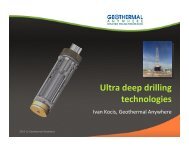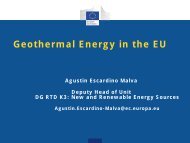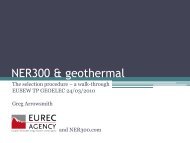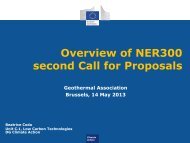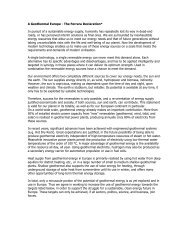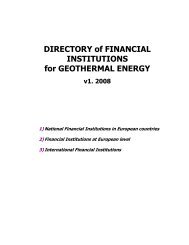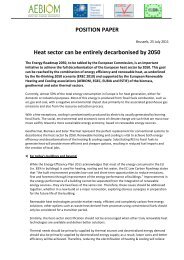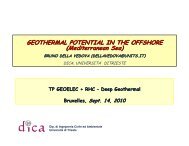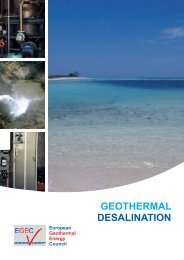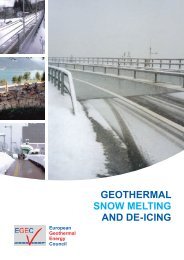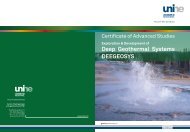Strategic Research and Innovation Agenda for Renewable ... - EGEC
Strategic Research and Innovation Agenda for Renewable ... - EGEC
Strategic Research and Innovation Agenda for Renewable ... - EGEC
Create successful ePaper yourself
Turn your PDF publications into a flip-book with our unique Google optimized e-Paper software.
M200300100200010002006/072006/072030102002020 2030 2050 10 2006/0702020 2030 2050 2006/07M2020 2030 2050<strong>Renewable</strong>Heating & CoolingEuropean Technology Plat<strong>for</strong>m2020 2030 2050MtoeMtoe7008000600 700500 600400 500700080006000700050006000400030050004003000200<strong>Renewable</strong> heat4000300Heat dem<strong>and</strong> BAU 20003000100 200Heat<strong>Renewable</strong>dem<strong>and</strong>heatRDP 1000Heat dem<strong>and</strong> BAU 2000100 0Heat dem<strong>and</strong> RDP010002006/07 2020 2030 2050002006/07 2020 2030 2050TWhTWhFigure 5 - Heating supply from renewable energy sources in EU. Source: RHC-Plat<strong>for</strong>m (2011)MtoeMtoe700600 7008000solar thermalaero/hydro HP70008000500geothermal solar HP6000600geothermal aero/hydro deep HP70005000400 500 biomass geothermal heatHP6000geothermal deep4000300 400 biomass heat500030004000200 30020003000100 200100 02006/07 2020 203010002000020501000002006/07 2020 2030 2050TWhTWhFigure 6 - Heating potential by renewable energy sources in EU. Source: RHC-Plat<strong>for</strong>m (2011)The enormous challenges ahead are not only technological. Tomorrow’s energy systems aredefined by the policy <strong>and</strong> legal frameworks we adopt today, which must provide the rightconditions to attract large-scale public <strong>and</strong> private investments. Public support will increaseas the full potential of social benefits, such as green jobs, is realised. Successful deploymentof renewable energy technologies also has to take into account the needs of end-users <strong>and</strong>of others affected by the technology 17 .In a global market, the main competitive strength of the European RHC industry is the highquality of its technologies. Recognition of EU-wide CEN st<strong>and</strong>ards, certification <strong>and</strong> qualitylabels must there<strong>for</strong>e be increased. The in<strong>for</strong>mation provided should not only include therelative efficiency, but also the annual running cost, greenhouse gas emissions <strong>and</strong> the expectedsystem lifetime. Market deployment also ought to be supported through policies favouringa stable <strong>and</strong> reliable framework <strong>for</strong> investors <strong>and</strong> at offsetting the high upfront costsassociated with RHC.17For instance, the EuropeanEnvironment Agency (EEA)estimated costs of air pollutionfrom the 10,000 largestpolluting facilities in Europebetween € 102 <strong>and</strong> 169 billionin 2009.Unlocking the potential of renewable heating <strong>and</strong> cooling (RHC) technologies requiresa substantial intensification of R&D activities as well as policy measures to overcomenon-technological barriers. The comprehensive agenda of priorities presented in thispublication gives decision-makers from the public <strong>and</strong> private sector a concrete toolto put the Common Vision into practice.9



